#Thalattosuchians
Text
obviously I can't include everything. Rip to the various groups I was forced to leave out, including Mesosaurs, my beloveds.
#tetrapods#marine reptiles#marine mammals#penguins#mosasaurs#plesiosaurs#cetaceans#sirenians#pinnipeds#desmostylians#thalattosuchians#dyrosaurids#pliosaurs#turtles
490 notes
·
View notes
Text
Just like the last time, all animals will behave as they would in nature (or as close to for all extinct species) the only difference is that your defender(s) will avoid causing friendly fire. However, any attempt to harm and/or eat your defender(s) will cause them to turn on you.
Also thought it wise to specify specific options to avoid confusion and people trying to bend the rules. (Sorry if I’m sounding like a party-pooper)
#poll#wet beast wednesday#invertibrates#cephalopods#crabs#cnidarians#siphonophore#fish#sharks#cetaceans#dolphin#extinct animals#plesiosaur#crocodylomorpha#thalattosuchians#mosasaurid#marine animals#marine life#marine biology
192 notes
·
View notes
Text
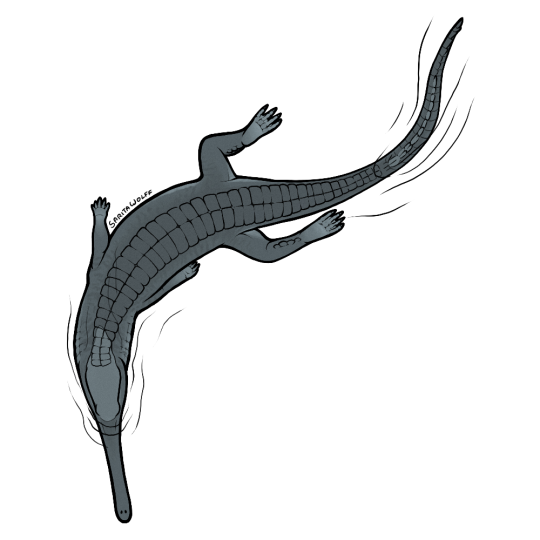
#Archovember Day 11 - Macrospondylus bollensis
The Thalattosuchians were a clade of marine pseudosuchians commonly called “marine crocodiles” or “sea crocodiles”. They were seperated into two groups, the Teleosauroids and the Metriorhynchoids. The metriorhynchoids seemed to be adapted for spending all their time in the water: they had smooth, scale-less skin, tail flukes, and even flippers. Meanwhile, teleosauroids held onto their crocodyliform nature, retaining their osteoderms and probably heading onto land when needed. They inhabited a wide range of habitats: from semi-marine coasts and estuaries, to open-ocean, to freshwater. The Early Jurassic Macrospondylus bollensis was one of these teleosauroids.
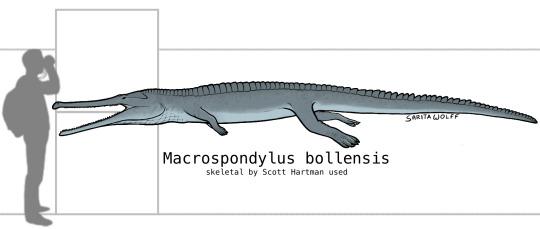
Macrospondylus bollensis, long known as “Steneosaurus bollensis” (Steneosaurus being a wastebasket taxon for thalattosuchians) finally had its genus revived in 2020. At 5.5 m (18 ft), it was the largest known Early Jurassic crocodylomorph. Like many other teleosauroids, it had a long, tapering snout, similar to its modern equivalents the gavialids. This snout would have allowed it to quickly maneuver through the water with little resistance, snapping up fish. Oddly enough, like Megalosaurus, Macrospondylus is also represented in the Crystal Palace gardens (though they are simply labeled as Teleosaurus). Modeled after gharials and based on much better preserved fossils than Megalosaurus, the teleosaur statues actually hold up pretty well, other than using a more crocodilian scute pattern.
Macrospondylus bollensis fossils have been found in Germany, the UK, and Luxembourg. It lived in the newly forming Tethys Sea, which was warm and shallow at the time, dotted with small tropical islands where Macrospondylus would have likely emerged to bask in the sun. This area is known for its fossilized crinoids, cephalopods, bivalves, crustaceans, ichthyosaurs, sharks, bony fish, and more, often exquisitely preserved “frozen in time” due to sudden events and nigh perfect fossilization factors. There was an abundance of fish here for Macrospondylus to feast upon, including chimaeras like Acanthorhina, the armoured Dapedium, the long-bodied Euthynotus, pups of the shark-like Hybodus, the herring-like Leptolepis, and many more. It would have lived alongside a variety of icthyosaurs, small plesiosaurs, other teleosauroids such as Mystriosaurus, Pelagosaurus, and Platysuchus, pterosaurs such as Campylognathoides and Dorygnathus, and come across sauropods such as Ohmdenosaurus wandering the shorelines. But Macrospondylus was not the biggest “fish” in the sea, and if it ventured into the open ocean it could have come across the 8–10 metre (26–33 ft) long icthyosaur Temnodontosaurus, the apex predator of the Early Jurassic Tethys Sea (which is also on display at the Crystal Palace!)
#my art#SaritaDrawsPalaeo#Macrospondylus#Macrospondylus bollensis#Teleosauroid#Teleosaur#Thalattosuchians#Crocodyliforms#pseudosuchians#archosaurs#archosauromorphs#reptiles#Archovember#Archovember2023
10 notes
·
View notes
Text
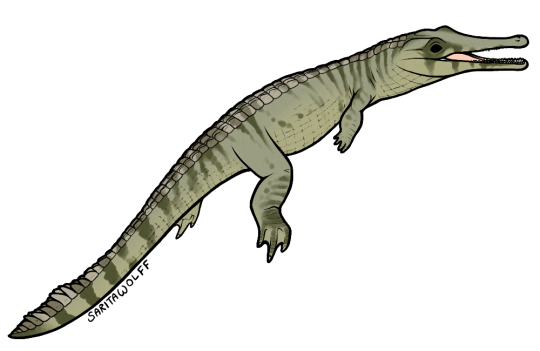
Patreon request for @/rome.and.stuff (Instagram handle) - Turnersuchus hingleyae
Described just last year, the Early Jurassic Turnersuchus is the most basal known member of the thalattosuchians: sea-dwelling crocodylomorphs. It existed before the two major thalattosuchian groups, the paddle-limbed Metriorhynchoidea and the long-snouted Teleosauroidea, split, and it may be the ancestor of both. While only parts of the skull are known, its shape suggests a narrow snout that was not as long as that of later thalattosuchians. Only one osteoderm is known, and it is oval with a slight keel down the middle, believed to have been attached to the tail. As humble as this small pseudosuchian was, it helped us fill in the major gaps of our understanding of thalattosuchia, and finally gave us an idea of their origin. Previously, all we knew was that the highly-derived metriorhynchoids and the more crocodile-like teleosauroids were related, lived alongside each other, and seemingly appeared in the Jurassic. While not as well known as the icthyosaurs, plesiosaurs, and mosasaurs, thalattosuchians were very successful sea crocodylomorphs until around the Early Cretaceous, and they owe their success to this little pseudosuchian who decided to return to the sea.
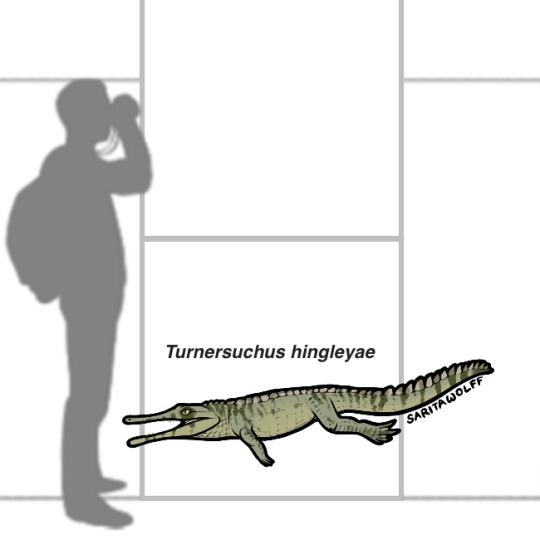
Found in the Charmouth Mudstone Formation of England, Turnersuchus would have lived alongside a variety of ammonites like Phricodoceras and Gemmellaroceras, as well as icthyosaurs like Leptonectes. It likely fed on the small fish that lived here. As it was not as highly adapted for ocean life as its descendants, it may have spent some time basking on land, where it could have come across early dimorphodontid pterosaurs and the armored Scelidosaurus.
#my art#Turnersuchus hingleyae#Turnersuchus#Thalattosuchians#crocodylomorphs#pseudosuchians#archosaurs#archosauromorphs#reptiles#SaritaDrawsPalaeo#Charmouth Mudstone Formation#Early Jurassic#England
2 notes
·
View notes
Photo
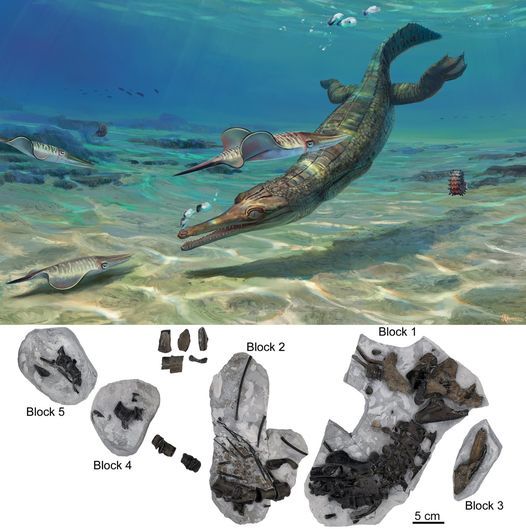
A new early diverging thalattosuchian (Crocodylomorpha) from the Early Jurassic (Pliensbachian) of Dorset, U.K. and implications for the origin and evolution of the group
Eric W. Wilberg,Pedro L. Godoy,Elizabeth F. Griffiths,Alan H. Turner &Roger B. J. Benson
ABSTRACT
Among archosaurs, thalattosuchian crocodylomorphs experienced the most extensive adaptations to the marine realm. Despite significant attention, the phylogenetic position of the group remains uncertain. Thalattosuchians are either the sister-group to Crocodyliformes, basal mesoeucrocodylians, or nest among longirostrine neosuchians.
The earliest definite thalattosuchians are Toarcian, and already possess many synapomorphies of the group. All phylogenetic hypotheses imply a ghost lineage extending at least to the Sinemurian, and a lack of older or more plesiomorphic forms may contribute to the uncertain phylogenetic placement of the group.
Here we describe a new species, Turnersuchus hingleyae, gen. et sp. nov., from the early Pliensbachian Belemnite Marl Member of the Charmouth Mudstone Formation (Dorset, U.K.). The specimen includes partially articulated cranial, mandibular, axial, and appendicular elements. It can be attributed to Thalattosuchia based on the following features: distinct fossa on the posterolateral corner of the squamosal; broad ventrolateral process of the otoccipital covering the dorsal surface of the quadrate; large supratemporal fenestrae lacking a flattened skull table; broadly exposed prootic; orbital process of quadrate lacking bony attachment with the braincase. This specimen represents the earliest thalattosuchian currently known from diagnostic material.
Phylogenetic analyses of two published datasets recover Turnersuchus as the earliest diverging thalattosuchian, and sister to Teleosauroidea + Metriorhynchoidea. Bayesian tip-dating analyses suggest a Rhaetian or Sinemurian divergence of Thalattosuchia from other crocodylomorphs, depending on topology, with confidence intervals spanning from the Norian to the Pliensbachian.
The new specimen extends the fossil record of Thalattosuchia, but the time-scaling analyses demonstrate that a significant ghost lineage remains.
Read the paper here:
https://www.tandfonline.com/doi/abs/10.1080/02724634.2022.2161909
23 notes
·
View notes
Text
Spectember/Spectober 2023 #08: Various Filter-Feeders
Admantus asked for a "freshwater baleen whale":
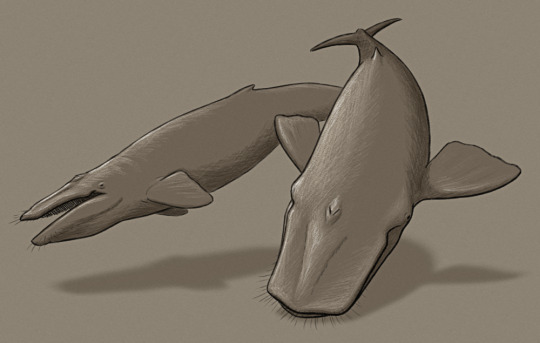
Rostrorutellum admantusi is descended from small cetotheres that became isolated in a large inland body of water (similar to the modern Caspian Sea), eventually becoming landlocked and gradually reducing in salinity towards fully freshwater.
Highly dwarfed in size, just 2-3m long (~6'6"-9'10"), they're slow swimmers with broad duck-like snouts that are used to scoop up mouthfuls of sediment and strain out their invertebrate prey in a similar feeding style to gray whales.
Due to the murkiness of the water, and the lack of large predators in their environment, they have poor eyesight and instead use sensory bristles and electroreceptors around their snouts to navigate and detect prey.
———
And an anonymous submission requested a "whale-like filter-feeding marine crocodile":

Sestrosuchus aigialus is a 6m long (~20') crocodilian closely related to the modern American crocodile, living in warm shallow coastal waters.
It's adapted for an almost fully aquatic lifestyle convergently similar to the ancient thalattosuchians, swimming with undulations of its long tail and steering with flipper-like limbs. But unlike other crocs it's specialized for filter-feeding, with numerous delicate needle-like teeth in its jaws that interlock to sieve out small fish and planktonic invertebrates from the water.
———
A couple more suggestions also asked for "fully aquatic pinnipeds" and "future crabeater seal evolution":

Euphausiolethrus volucer is a fully aquatic descendant of the crabeater seal. About 5m long (~16'4"), it occupies the ecological niche of a small baleen whale in the krill-abundant Antarctic waters that lack most actual baleen whales.
Its jaws contain numerous finely-lobed teeth that are used to strain krill from the water, and it utilizes all four of its wing-like flippers to swim in an "underwater flight" motion similar to that of plesiosaurs.
Highly social, it tends to congregate in pods that cooperate to herd swarms of krill for easier feeding.
#spectember#spectober#spectember 2023#speculative evolution#whale#cetacean#seal#pinniped#mammal#crocodile#pseudosuchia#archosaur#art#science illustration
246 notes
·
View notes
Text
Why crocodile-line archosaurs are cooler than you think
Pseudosuchian evolution is like really, really underrated. Like people learn a version of "crocodiles have been around for 200 million years" even though pseudosuchians have a super interesting and diverse history. Some forms even converged on the "primitive dinosaur" body plan, despite not being dinosaurs at all!
In rough order of divergence:

Desmatosuchus, an aetosaur

Arizonasaurus, a poposauroid
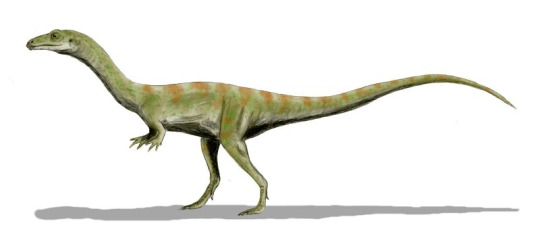
Shuvosaurus, another poposauroid (not a dinosaur!)

Postosuchus, a rauisuchid

Terrestrisuchus, an early crocodylomorph

Neptunidraco, a thalattosuchian

Baurusuchus, a sebecosuchian
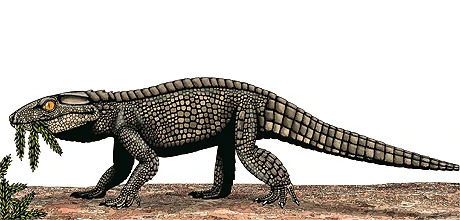
Chimaerasuchus, a notosuchian
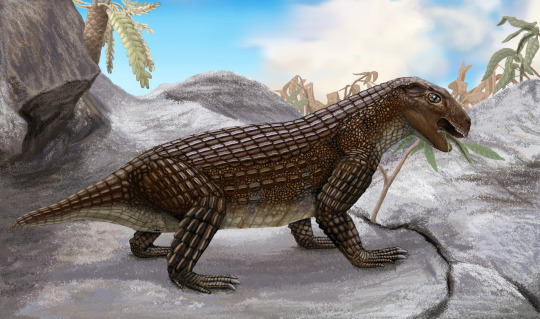
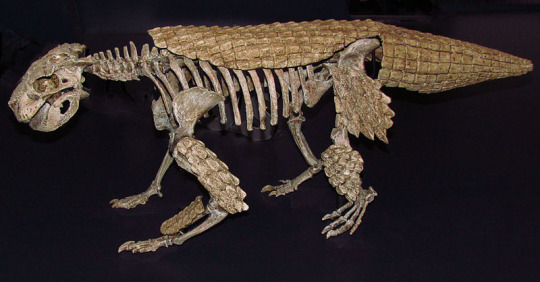
Simosuchus, another notosuchian

Anatosuchus, a crocoduck notosuchian

Yacarerani, yet another notosuchian
While bird-line archosaurs are fluffier, and have been much more widespread since the Jurassic, pseudosuchians displayed a much wider range of adaptations than we gave them credit for - from fully aquatic thalattosuchians to small terrestrial, herbivorous, armored notosuchians!
241 notes
·
View notes
Text
Thalattosuchus and Leedsichthys
Quickly stopping by to report on a new paper describing stomach contents of a thalattosuchian (Jurassic marine crocodile).
The paper in brief describes a specimen of Metriorhynchus superciliosus (aka Thalattosuchus) with preserved stomach contents, which is already rare enough as is. What's even more interesting is that the stomach contents preserve both the gill rakes of the large fish Leedsichthys as well as various mollusc shells. Strange prey for what's a rather small piscivore. Although it was previously suggested that Metriorhynchus/Thalattosuchus attacked living Leedsichthys, this appears to have been based on missinterpreted evidence and given the enormous size difference its way more likely that the fish was simply scavenged, sorta like a kind of Jurassic whalefall. This actually finds support in the mollusc shells, which might have been ingested on accident alongside the fish remains.
Top left: The skeleton of this Thalattosuchus specimen
Top right: The stomach contents in detail (G are gill rakes, S are shells)
Bottom left: Live reconstriction of Thalattosuchus by Gabriel Ugueto
Bottom right: Live reconstruction of Leedsichthys by @knuppitalism-with-ue
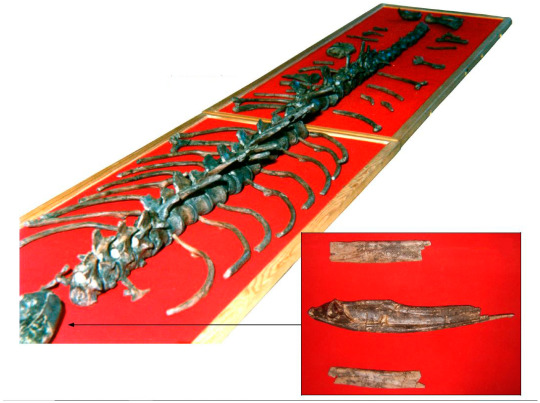
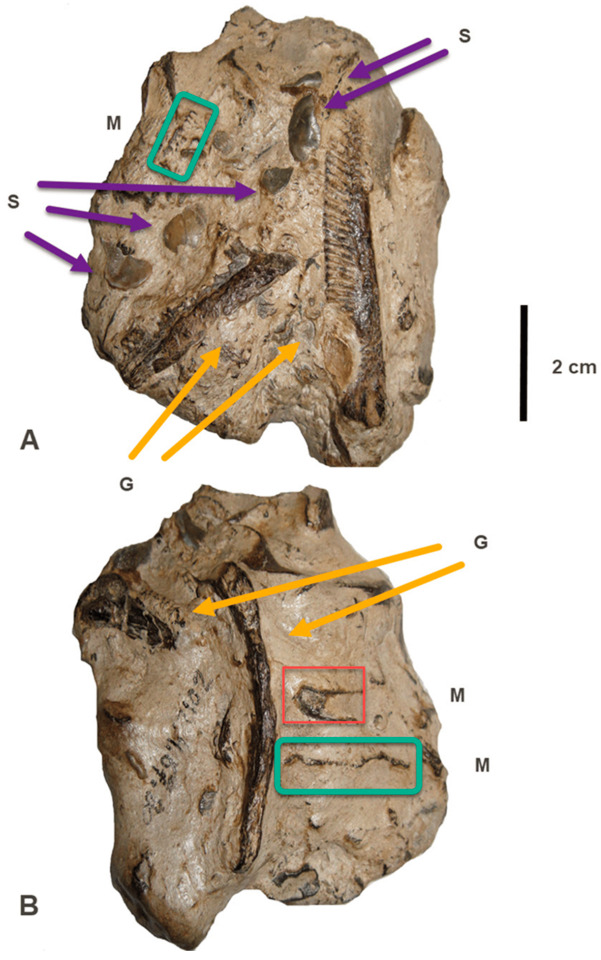
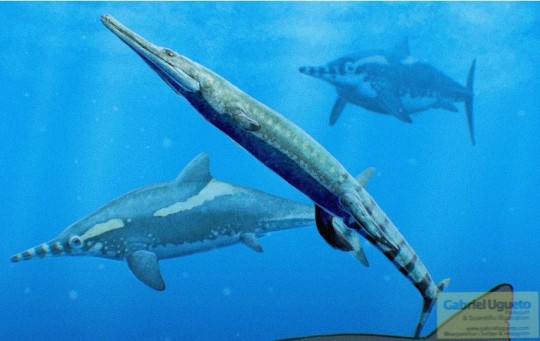

The paper itself:
Fossil Studies | Free Full-Text | The Diet of Metriorhynchus (Thalattosuchia, Metriorhynchidae): Additional Discoveries and Paleoecological Implications (mdpi.com)
#thalattosuchus#thalattosuchia#metriorhynchus#metriorhynchidae#leedsichthys#palaeoblr#paleontology#prehistory#jurassic
37 notes
·
View notes
Note
any scaleless/smooth dragons out there? (saw an olm and reminded me of some kind of wyrm)
Yes!
So my dragons are crocodylomorphs, most of their body scales are osteoderms - very heavy bone scales. Magical flying species do not mind this, terrestrial species are glad of the armour, but marine sea serpents find the extra weight a bit much, and so have evolved to not be covered in osteoderms - this is a nod to my research on thalattosuchian crocodylomorphs moreso than something in keeping with my current dragon designs.
Questions like "well if your aquatic sea serpents don't have scales, why don't your aquatic wyrms?" and "well, crocodiles can swim just fine with their osteoderms, why do your sea serpents NOT have them?" are both answered with "I studied thalattosuchians professionally for a few years, I want to have pelagic crocodylmorph trivia in my silly dragon book" <3
Sadly the sea serpents aren't olm-slimy, they are more... leathery? Blubbery? Think leatherback turtle, porpoise, whale... smooth sea beast...
9 notes
·
View notes
Text
Crelog #2
(for optimal viewing, please use a computer and blog address ^^)
This is the second Novinitum D crelog! (a.k.a. creator log. I know, very creative). These are basically like devlogs but for my specevo and worldbuilding projects. Entries where it's me updating yall on the behind-the-scenes stuff and also asking for feedback on occasion, maybe even a poll, we'll see.
It's been a while! Happy 2024! In this entry I'll be discussing some major changes about the planet + a tentative list of seeding taxa! It's very brief but I think I owe it to the very small handful of people who've shown interest in this project.
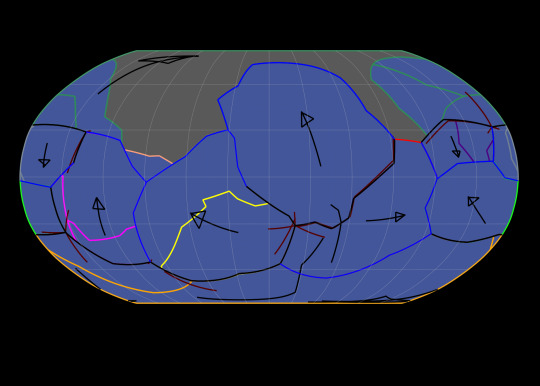
sneak peak into what this crelog features
Previous crelog [#1] <- [#2] -> Next crelog [#3]
🗒️Crelogs🗒️
~~~~~🌎🌍🌏~~~~~

the state of the world map at 0 MY (the massive blank space is part of a plate which is too big for gplates to render)
The eagle-eyed amongst you will notice that not only is this an entirely different map, but that I'm starting from an entirely different method. Instead of starting with a super continent which splits apart - like in Worldbuilding Pasta's method (link to their blog here) - I've started from the oceanic plates first, essentially starting the world from scratch. The map at 50 MY will be seen when I reveal the name of the first time period.
~~~~~🐟🐟🐟~~~~~
This list is very tentative but most likely will stay the same:
Animals:
Operculaurisichthys
made up fully pelagic Grimothea species
reef building oysters
scallops
copepods
made up Argyroneta species
clam shrimp of marine and freshwater varieties
made up thalattosuchian genus
made up starfish genus
made up Ptychoceras species
made up Squalus species
made up lanternfish species
made up pycnodont species
Plants:
Zostera marina
indeterminate algae
Valonia ventricosa
indeterminate phytoplankton
Fungi:
marine lichens (I know these aren't true fungi but for simplicity's sake they're here)
That's all for now! There should be more coming soon since progress has been incredibly quick since the change in plate tectonic method
#NovinitumDCrelog#worldbuilding#spec evo#speculative biology#speculative zoology#GPlates#plate tectonics
8 notes
·
View notes
Text
My second paper is out!
I'm second author rather than first on this one, but if you have any questions on it feel free to reach out! It's about the grooves we found on the palates of fossil crocodylomorph skulls! These palatal grooves (PG in the thumbnail image) are found in Thalattosuchians, crocodylomophs adapted for live at sea!
34 notes
·
View notes
Text
Triassic collision: The high lizards.




During the early jurassic, the coelurosaurs would also diversify but with the rauisuchians around. They would be restricted to smaller forms.
However, the rauisichians would eventually go extinct by the end of the middle jurassic. Finally giving the dinosaurs a chance to once again reign over the earth.
While tyrannosauroids and dromaeosauroids would also evolve during this period, the late jurassic would instead be ruled by a group known as the acrosauroids.
The acrosauroids, also known as the high lizards. Were the first theropods to reach sizes that we would consider big. They would quickly evolve and fill different niches.
The smallest and most basal of the acrosauroids would be the monoceratosaurus (One horned lizard), this is especially obvious by its smaller size and thinner build. Only weighing 1 ton despite being almost the same height and length as the ceratosaurus from our universe. These animals usually prey on smaller prey like deer sized mammaliformes or other coelurosaurs, and are especially known to target the eggs most of the time. One interesting thing about this animal is its single horn on its nose, which is considered to be used for attracting mates.
Then we have acrosaurus (High lizard), which the entire group is named after. Being the most popular and also the first acrosauroid, this animal is iconic for its large sail on its tail. The exact purpose of the tail is still unknown, but its mostly considered to be used for attract mates or for heat regulation and cooling the animal. Acrosaurus was by far the most successful predator of the late jurassic, hunting large herbivores and chasing out other theropods of the area.
However, the largest acrosauroid by far would be gigsaurus (Gigantic lizard). The most interesting part of this dinosaur is its hump or sail on its neck, the purpose of this hump has debated because of its odd placement. Not only that, the hump would have also restricted the animals neck movement. Because of this, it is believed that gigasaurus would have hunted smaller prey or scavenged food. This is also not helped by the gigasaurus's fragmentary nature, with the first fossil ever discovered being mistaken to be an acrosaurus. Not only, the gigsaurus is also believed to be closely related to acrosaurus but this has also been debated. Unless more material is found, the gigsaurus and its hump still stays a mystery.
The final acrosauroid that we are gonna talk about is the carcharosaurus (Shark lizard), what makes this acrosauroid interesting is its aquatic adaptations. As younglings, the carcharosaurus are born with 2 fingers with their third finger having evolved into a fin. But as they get older, their fingers eventually fingers will smaller before completely disapearing. It's believed to have hunted near the shores, lakes, and rivers. Their diet consisted of fish, crocodiles, thalattosuchians, small mammaliformes and coelurosaurs.
3 notes
·
View notes
Note
If you were to take a crack at it, what would you classify the red bluster as?
For a lot of the sea monsters there’s some weird stuff going on anatomy wise, but presumably this isn’t like a huge alternate evolution setting since seabirds, horses, fish, and people exist, and dogs and cats are mentioned offhand. Likely something about the dreadmaw itself fucks with the evolution of creatures and makes kaiju (and possibly witches).
BUT! I do think I have an idea of what the red bluster could be. Obviously it’s a reptile but the up and down motion of the tail is rather odd for a reptile. That kind of movement would require a spine that’s flexible moving up and down and the only diapsids that can do that are the Crocodylomorpha. The vertebrae of Crocodylomorpha have ball and socket joints, which gives them surprising flexibility (and that’s also why there wasn’t a single bipedal member of the group because with a spine like that it’s better to gallop). However I don’t think the red bluster is related to marine members of this group as Thalattosuchians swam with side to side movements of the tail. Red blusters likely descend from a Crocodylomorph group that was completely terrestrial and then became marine independently of them.
Also modern Crocodylomorphs are pretty smart and some can follow simple commands, just like Red!
#ask#questions#speculative zoology#speculative evolution#speculative biology#the sea beast#red bluster#batwards running
59 notes
·
View notes
Photo

Ancient Jurassic Predator Emerged From Ghost Ancestor, Scientists Say
In the Early Jurassic, before the mass extinction event that brought about the demise of most dinosaurs, the ancestors of crocodiles had a whole bunch of relatives living in the sea.
Researchers have found the oldest fossils yet of these ancient marine predators in the United Kingdom and Morocco. They say the remains hint at a 'ghostly' ancestor that has never been found in fossil form.
Ancient 'marine crocodiles' are known scientifically as thalattosuchians, of which numerous different species once existed. Although some thalattosuchians grew as long as 10 meters (33 feet), the newfound creature measured about 2 meters and possessed short limbs and a long, strong tail...
Read more: https://www.sciencealert.com/ancient-jurassic-predator-emerged-from-ghost-ancestor-scientists-say
16 notes
·
View notes
Text
incredibly shook to learn that every mesozoic marine reptile group except for thalattosuchians and mososaurs may have come from the same, likely already aquatic, ancestor
6 notes
·
View notes
Text
New ancient 'marine crocodile' discovered on UK's Jurassic Coast one of the oldest specimens of its type ever found#ancient #marine #crocodile #discovered #UKs #Jurassic #Coast #oldest #specimens #type
Turnersuchus hingleyae by Júlia d’Oliveira. Credit: Júlia d’Oliveira
A new study has uncovered a new thalattosuchian—an ancient ‘sister’ of modern-day crocodiles’ ancestors.
The discovery of Turnersuchus hingleyae follows an impressive unearthing of fossils on the Jurassic Coast, in Dorset, UK, including part of the head, backbone, and limbs.In fact, the find at the Charmouth Mudstone Formation…

View On WordPress
0 notes